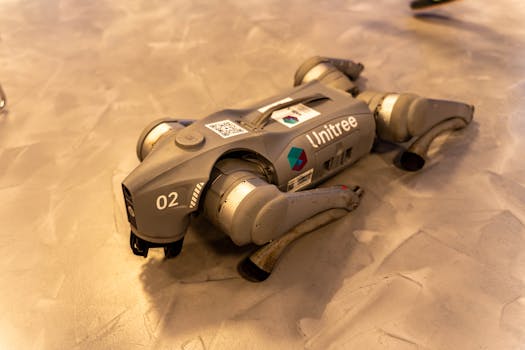Unlock the Forge: Build Your D&D 5e Automaton Stat Block with Ease
Introduction
Ever found yourself staring at a blank page, a half-finished campaign, and a sudden craving for a clockwork companion or a golem guardian? Building custom monsters in Dungeons & Dragons 5th Edition can be a blast, but when it comes to creating something as unique as an automaton, the process can feel a little… mechanical. You want a creature that’s more than just gears and springs; you want a truly memorable addition to your world. But where do you even begin to craft a compelling D&D 5e automaton stat block?
The challenge lies in balancing thematic flavor with mechanical viability. You need your automaton to feel like a marvel of engineering, a relentless machine, or perhaps a surprisingly sentient construct. This blog post is your ultimate guide to demystifying the creation of a D&D 5e automaton stat block. We’ll walk you through the core concepts, break down the essential components, explore real-world applications, and arm you with the knowledge to forge your own unique clockwork creations!

The Art of the Automaton: More Than Just Metal
Automata in Dungeons & Dragons are typically constructs – creatures brought to life through arcane or technological means, rather than natural birth or divine intervention. Think of ancient dwarven clockwork soldiers, arcane laboratories teeming with animated servants, or even the remnants of a lost, technologically advanced civilization. They offer a fantastic opportunity to inject a unique flavor into your game, whether they serve as allies, formidable foes, or puzzling inhabitants of forgotten ruins.
The relevance of automata in modern D&D 5e gaming is undeniable. They allow Dungeon Masters to move beyond traditional fantasy tropes and explore themes of artificial intelligence, the ethics of creation, and the intersection of magic and technology. A well-crafted automaton stat block can challenge players in new ways, offering different tactical considerations than a typical goblin or dragon.
Your D&D 5e Automaton Stat Block: A Step-by-Step Forge
Creating a robust D&D 5e automaton stat block involves several key considerations. We’ll break these down, ensuring you have a clear roadmap to success.
- Understanding the Core Concept: What kind of automaton are you envisioning? Is it a simple servant, a military machine, or something more complex with emergent sentience? This foundational decision will guide every subsequent choice.
- Choosing the Right Base Creature Type: While most automata are Constructs, consider if an Undead or even Aberration type might fit a more bizarre or corrupted creation.
- Determining Challenge Rating (CR) and Encounter Balance: This is crucial for ensuring your automaton fits the desired difficulty for your player characters.
- Assigning Ability Scores: Strength for brute force, Dexterity for precision, Constitution for durability, Intelligence for complex functions, Wisdom for sensory input, and Charisma for commanding presence – or lack thereof.
- Crafting Proficiencies and Saving Throws: What skills does your automaton excel at?
- Designing Attacks and Damage: What are its primary means of offense?
- Developing Special Traits and Actions: This is where the true automaton flavor shines!
- Considering Resistances, Immunities, and Vulnerabilities: What makes it uniquely a construct?
Let’s dive deeper into each of these crucial elements for building your D&D 5e automaton stat block.
1. The Heart of the Machine: Ability Scores
Ability scores are the bedrock of any D&D 5e automaton stat block. For a typical automaton, you’ll often see a focus on Strength, Constitution, and perhaps Intelligence.
* **Strength (STR):** Essential for any automaton designed for physical labor or combat. High Strength means powerful strikes and heavy lifting.
* **Dexterity (DEX):** Important for automata focused on speed, accuracy, or intricate tasks. A nimble automaton might have a higher Dexterity.
* **Constitution (CON):** This determines hit points and a construct’s resilience. Automata are generally tough, so expect good Constitution. A high Constitution score is paramount for survivability.
* **Intelligence (INT):** Crucial for automata with complex programming, tactical analysis, or even rudimentary AI. Think of a siege automaton with advanced targeting systems.
* **Wisdom (WIS):** Represents awareness and perception. A scouting automaton or one designed to observe its environment might have decent Wisdom.
* **Charisma (CHA):** Often low for mindless constructs, but can be surprisingly high for automata designed to lead or deceive. A diplomatic automaton might invest here.
When assigning scores, think about the automaton’s intended purpose. A lumbering guardian might have high STR and CON, while a delicate clockwork spy might prioritize DEX and INT.
2. The Blueprint: Hit Points and Armor Class
Hit points are determined by Constitution modifier and Hit Dice. For constructs, you often have a fixed number of Hit Dice based on their size, and their Constitution modifier is usually fixed based on their Intelligence score (if they are unintelligent) or their actual Constitution score.
Armor Class (AC) is another vital component. Automata often have natural armor due to their metallic or composite bodies. This natural armor can be a significant part of their survivability. You might also grant them proficiency in medium or heavy armor if they are designed to wear it.

3. The Tools of the Trade: Attacks and Damage
Every automaton needs a way to interact with the world, usually through attacks. These can be simple melee attacks, ranged projectile attacks, or even specialized energy blasts.
* **Melee Attacks:** Think of integrated weapons like clawed hands, hammers, or blades. A Gargoyle’s slam is a good example of a built-in melee attack.
* **Ranged Attacks:** This could be integrated crossbows, cannons, or arcane energy projectors. A warforged titan might have a powerful integrated cannon.
* **Damage Types:** Automata often deal bludgeoning, piercing, or slashing damage with their physical attacks. For more advanced constructs, consider force, lightning, or even fire damage for energy-based attacks.
When designing these, remember to consider the automaton’s size and intended role. A small clockwork servant might have a single, weak piercing attack, while a colossal war machine could unleash devastating area-of-effect damage.
4. The Soul of the Machine: Special Traits and Actions
This is where you inject the true essence of your automaton. What makes it unique? What special abilities does it possess?
* **Construct Nature:** Many automata are immune to certain conditions like charmed, frightened, poisoned, and exhausted. They also often have immunity to disease and don’t need to eat, sleep, or breathe. These immunities are hallmarks of the Construct creature type.
* Immutable Form: Constructs cannot alter their form except by magical means.
* Magic Resistance: Some more advanced automata might have advantage on saving throws against spells and other magical effects.
* Mechanical Proficiency: Perhaps your automaton has advantage on checks related to mechanical devices or traps.
* Repair Protocols: Can it self-repair, or does it require specific tools or spells to mend?
* Integrated Systems: Think about built-in sensors, targeting computers, or even communication arrays.
Special Actions can include things like:
* **Overdrive Mode:** A temporary boost to speed or damage at the cost of durability.
* Analyze Weakness: A way to identify vulnerabilities in opponents.
* Deploy Minions: A larger automaton might release smaller, specialized drones.
* Arcane Discharge: A burst of magical energy.
These special traits and actions are what truly bring your D&D 5e automaton stat block to life and differentiate it from other monsters.
5. The Weaknesses of the Flesh (or Lack Thereof): Resistances, Immunities, and Vulnerabilities
Constructs often have unique resistances, immunities, and vulnerabilities that reflect their artificial nature.
* **Immunities:** As mentioned, common immunities include poison, disease, exhaustion, charmed, frightened, and paralyzed. They also don’t typically suffer critical hits if they are unintelligent.
* Resistances: Some might resist non-magical bludgeoning, piercing, and slashing damage, reflecting their sturdy construction.
* Vulnerabilities: Consider vulnerabilities that make sense thematically. Perhaps adamantine weapons bypass their natural armor, or they are particularly vulnerable to lightning if they run on stored electrical energy. Acid might corrode their components. Understanding vulnerabilities is key to making them beatable.

6. The Grand Design: Challenge Rating and Encounter Balance
When building any D&D 5e automaton stat block, keeping the Challenge Rating (CR) in mind is essential. The DMG (Dungeon Master’s Guide) provides excellent guidelines for calculating CR based on offensive and defensive CR.
* **Offensive CR:** Determined by average damage per round and the chance to hit.
* Defensive CR: Determined by Armor Class, hit points, and saving throw bonuses.
You can use existing stat blocks as a reference. For example, a Shield Guardian has a CR of 7 and provides a good template for a sturdy, combat-oriented construct. If you’re creating something simpler, like a clockwork servant, you might aim for a CR of 1/4 or 1/2. Proper CR calculation ensures your encounters are challenging but fair.
Real-World Application: Crafting Specific Automata
Let’s put this knowledge into practice with a couple of example concepts for your D&D 5e automaton stat block.
The Clockwork Sentinel
Imagine a tireless guardian, designed to patrol ancient ruins or protect a wizard’s tower.
* **Concept:** Medium Construct, Lawful Neutral
* **Abilities:** High Strength and Constitution, moderate Dexterity, low Intelligence and Charisma, decent Wisdom for perception.
* **Attacks:** Integrated mace (bludgeoning damage), possibly a hand crossbow.
* **Special Traits:** Immunity to exhaustion and charm, resistance to non-magical bludgeoning, piercing, and slashing damage. Maybe a “Detect Intruder” passive ability that grants it advantage on perception checks in its designated area.
* **CR Goal:** 2-3
The Arcane Automaton Assistant
This automaton might be a bit more fragile but possesses greater utility and intelligence.
* **Concept:** Small Construct, Neutral
* **Abilities:** High Intelligence, moderate Dexterity, average Constitution, low Strength and Charisma.
* **Attacks:** A minor magical bolt (force damage), perhaps a precision manipulator arm for fine tasks.
* **Special Traits:** Proficiency in Investigation and Arcana, ability to cast a few utility cantrips like Mage Hand or Light. Perhaps a vulnerability to lightning damage if its power core is exposed.
* **CR Goal:** 1/2-1
For further inspiration on building custom creatures, check out this guide to crafting custom monsters. You might also find valuable tools and resources on websites like AI-aided D&D monster creators, which can help streamline the process.
Pros and Cons of Building Custom Automata
Building your own D&D 5e automaton stat block offers immense creative freedom, but it also comes with its own set of considerations.
| Pros | Cons |
|---|---|
| ➕ Unparalleled Creative Freedom | ➖ Can be time-consuming to balance |
| ➕ Tailored to Your Campaign’s Lore | ➖ Requires a good understanding of game mechanics |
| ➕ Creates Unique Player Challenges | ➖ Risk of making them too powerful or too weak |
| ➕ Enhances World-Building Immersion | ➖ May require iterative adjustments after playtesting |
Conclusion
Building a D&D 5e automaton stat block is a rewarding aspect of Dungeon Mastering, allowing you to imbue your world with unique mechanical wonders. By understanding the core components – ability scores, hit points, attacks, special traits, and resistances – you can forge creatures that are both thematically resonant and mechanically sound. Remember to consider your automaton’s purpose, its intended challenge rating, and the unique flavor you want to bring to your table.
Don’t be afraid to experiment! Start with a simple concept and gradually build complexity. The most important thing is to have fun and create memorable encounters for your players. So, fire up your imagination, gather your tools, and start building your next mechanical marvel. Your players will thank you for the unique challenge and the rich storytelling opportunities that a well-crafted automaton provides. Now, go forth and create!